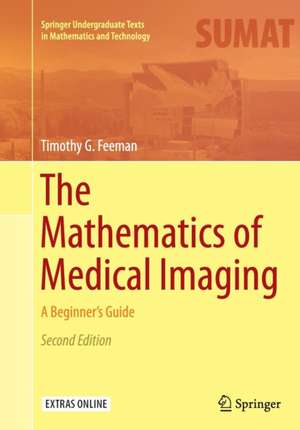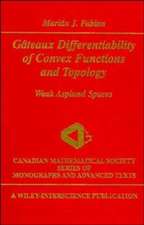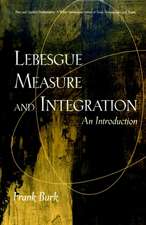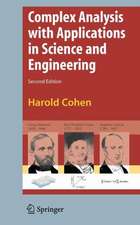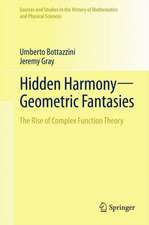The Mathematics of Medical Imaging: A Beginner’s Guide: Springer Undergraduate Texts in Mathematics and Technology
Autor Timothy G. Feemanen Limba Engleză Paperback – 29 oct 2016
Extending the ideas of the acclaimed first edition, new material has been adeed to render an even more accessible textbook for course usage. This edition includes new discussions of the Radon transform, the Dirac delta function and its role in X-ray imaging, Kacmarz’s method and least squares approximation, spectral filtering, and more. Copious examples and exercises, new computer-based exercises, and additional graphics have been added to further delineate concepts. The use of technology has been revamped throughout with the incorporation of the open source programming environment R to illustrate examples and composition of graphics. All R code is available as extra source material on SpringerLink.
From the reviews of the first edition:
“This book is valuable, for it addresses with care and rigor the relevance of a variety of mathematical topics to a real-world problem. …T
his book is well written. It serves its purpose of focusing a variety of mathematical topics onto a real-world application that is in its essence mathematics.”
–The Journal of Nuclear Medicine, Vol. 51 (12), December, 2010 “This new book by Timothy Feeman, truly intended to be a beginner’s guide, makes the subject accessible to undergraduates with a working knowledge of multivariable calculus and some experience with vectors and matrix methods. …author handles thematerial with clarity and grace…”
–The Mathematical Association of America, February, 2010
| Toate formatele și edițiile | Preț | Express |
|---|---|---|
| Paperback (1) | 421.91 lei 38-44 zile | |
| Springer International Publishing – 29 oct 2016 | 421.91 lei 38-44 zile | |
| Hardback (1) | 438.10 lei 38-44 zile | |
| Springer International Publishing – 28 noi 2015 | 438.10 lei 38-44 zile |
Din seria Springer Undergraduate Texts in Mathematics and Technology
- 13%
 Preț: 357.85 lei
Preț: 357.85 lei -
 Preț: 412.77 lei
Preț: 412.77 lei -
 Preț: 499.87 lei
Preț: 499.87 lei -
 Preț: 407.37 lei
Preț: 407.37 lei - 15%
 Preț: 494.43 lei
Preț: 494.43 lei -
 Preț: 377.88 lei
Preț: 377.88 lei -
 Preț: 413.88 lei
Preț: 413.88 lei - 13%
 Preț: 388.57 lei
Preț: 388.57 lei - 17%
 Preț: 365.99 lei
Preț: 365.99 lei - 17%
 Preț: 367.30 lei
Preț: 367.30 lei - 19%
 Preț: 465.39 lei
Preț: 465.39 lei -
 Preț: 998.07 lei
Preț: 998.07 lei -
 Preț: 391.61 lei
Preț: 391.61 lei - 15%
 Preț: 487.90 lei
Preț: 487.90 lei -
 Preț: 391.79 lei
Preț: 391.79 lei -
 Preț: 472.90 lei
Preț: 472.90 lei -
 Preț: 422.03 lei
Preț: 422.03 lei - 15%
 Preț: 482.97 lei
Preț: 482.97 lei -
 Preț: 246.75 lei
Preț: 246.75 lei -
 Preț: 410.46 lei
Preț: 410.46 lei -
 Preț: 407.57 lei
Preț: 407.57 lei - 15%
 Preț: 522.34 lei
Preț: 522.34 lei - 15%
 Preț: 486.91 lei
Preț: 486.91 lei - 20%
 Preț: 338.50 lei
Preț: 338.50 lei -
 Preț: 660.93 lei
Preț: 660.93 lei - 15%
 Preț: 504.99 lei
Preț: 504.99 lei - 20%
 Preț: 424.22 lei
Preț: 424.22 lei - 15%
 Preț: 487.74 lei
Preț: 487.74 lei -
 Preț: 460.91 lei
Preț: 460.91 lei -
 Preț: 1072.26 lei
Preț: 1072.26 lei -
 Preț: 390.73 lei
Preț: 390.73 lei -
 Preț: 421.72 lei
Preț: 421.72 lei - 19%
 Preț: 474.42 lei
Preț: 474.42 lei
Preț: 421.91 lei
Nou
Puncte Express: 633
Preț estimativ în valută:
80.76€ • 87.75$ • 67.88£
80.76€ • 87.75$ • 67.88£
Carte tipărită la comandă
Livrare economică 16-22 aprilie
Preluare comenzi: 021 569.72.76
Specificații
ISBN-13: 9783319331072
ISBN-10: 3319331078
Pagini: 211
Ilustrații: XIV, 197 p. 38 illus.
Dimensiuni: 178 x 254 x 11 mm
Greutate: 0.38 kg
Ediția:Softcover reprint of the original 2nd ed. 2015
Editura: Springer International Publishing
Colecția Springer
Seria Springer Undergraduate Texts in Mathematics and Technology
Locul publicării:Cham, Switzerland
ISBN-10: 3319331078
Pagini: 211
Ilustrații: XIV, 197 p. 38 illus.
Dimensiuni: 178 x 254 x 11 mm
Greutate: 0.38 kg
Ediția:Softcover reprint of the original 2nd ed. 2015
Editura: Springer International Publishing
Colecția Springer
Seria Springer Undergraduate Texts in Mathematics and Technology
Locul publicării:Cham, Switzerland
Cuprins
Preface to Second Edition.-Preface.- 1. X-rays.- 2. The Radon Transform.- 3. Back Projection.- 4. Complex Numbers.- 5. The Fourier Transform.- 6. Two Big Theorems.- 7. Filters and Convolution.- 8. Discrete Image Reconstruction.- 9. Algebraic Reconstruction Techniques.- 10. MRI—An Overview.-Appendix A. Integrability.- Appendix B. Matrices, Transposes, and Factorization.- Appendix C.Topics for Further Study.- Bibliography.- Index.
Recenzii
“The text is concise, lucidly written and coherently structured. It is also self-contained and easily accessible to any undergraduate student having a solid command of mathematics at the level of some introductory courses in algebra and analysis. The code written in R is a genuine asset of high practical and educational value. Overall, this textbook provides good, highly informative, and useful material to students and all of those with interest in medical imaging.” (Witold Pedrycz, zbMATH 1351.92002, 2017)
“I believe that the book is a useful starting point for undergraduate students from mathematics, computer science, and related fields who want to learn how CT works; it also provides interesting reading for people from medical areas who want to find out the technical and mathematical background of the tools that they use.” (Kai Diethelm, Computing Reviews, computingreviews.com, May, 2016)
“I believe that the book is a useful starting point for undergraduate students from mathematics, computer science, and related fields who want to learn how CT works; it also provides interesting reading for people from medical areas who want to find out the technical and mathematical background of the tools that they use.” (Kai Diethelm, Computing Reviews, computingreviews.com, May, 2016)
Notă biografică
Timothy G. Feeman is professor of mathematics, Villanova University, in Lancaster, Pennsylvania. His original area of research is the theory of operators on Hilbert spaces once described as "the field of mathematics that has the strongest interaction with the scientific and technological developments which are characteristic of the twentieth century." Since the mid- to late-1990s, his scholarly efforts have become more diversified.
Textul de pe ultima copertă
The basic mathematics of computerized tomography, the CT scan, are aptly presented for an audience of undergraduates in mathematics and engineering. Assuming no prior background in advanced mathematical analysis, topics such as the Fourier transform, sampling, and discrete approximation algorithms are introduced from scratch and are developed within the context of medical imaging. A chapter on magnetic resonance imaging focuses on manipulation of the Bloch equation, the system of differential equations that is the foundation of this important technology.
Extending the ideas of the acclaimed first edition, new material has been added to render an even more accessible textbook for course usage. This edition includes new discussions of the Radon transform, the Dirac delta function and its role in X-ray imaging, Kacmarz’s method and least squares approximation, spectral filtering, and more. Copious examples and exercises, several new computer-based exercises, and additional graphics have been added to further delineate concepts. The use of technology has been revamped throughout with the incorporation of the open source programming environment R to illustrate examples and composition of graphics. All R code is available as extra source material on SpringerLink.
From the reviews of the first edition:
“This book is valuable, for it addresses with care and rigor the relevance of a variety of mathematical topics t
o a real-world problem. …This book is well written. It serves its purpose of focusing a variety of mathematical topics onto a real-world application that is in its essence mathematics.”
–The Journal of Nuclear Medicine, Vol. 51 (12), December, 2010
“This new book by Timothy Feeman, truly intended to be a beginner’s guide, makes the subject accessible to undergraduates with a working knowledge of multivariable calculus and some experience with vectors and matrix methods. …author handles the material with clarity and grace…”
–The Mathematical Association of America, February, 2010
“All theoretical material is illustrated with carefully selected examples which are easy to follow. …I highly recommend this interesting, accessible to wide audience and well-written book dealing with mathematical techniques that support recent ground-breaking discoveries in biomedical technology both to students…and to specialists.”
–Zentralblatt MATH, Vol. 1191, 2010
Extending the ideas of the acclaimed first edition, new material has been added to render an even more accessible textbook for course usage. This edition includes new discussions of the Radon transform, the Dirac delta function and its role in X-ray imaging, Kacmarz’s method and least squares approximation, spectral filtering, and more. Copious examples and exercises, several new computer-based exercises, and additional graphics have been added to further delineate concepts. The use of technology has been revamped throughout with the incorporation of the open source programming environment R to illustrate examples and composition of graphics. All R code is available as extra source material on SpringerLink.
From the reviews of the first edition:
“This book is valuable, for it addresses with care and rigor the relevance of a variety of mathematical topics t
o a real-world problem. …This book is well written. It serves its purpose of focusing a variety of mathematical topics onto a real-world application that is in its essence mathematics.”
–The Journal of Nuclear Medicine, Vol. 51 (12), December, 2010
“This new book by Timothy Feeman, truly intended to be a beginner’s guide, makes the subject accessible to undergraduates with a working knowledge of multivariable calculus and some experience with vectors and matrix methods. …author handles the material with clarity and grace…”
–The Mathematical Association of America, February, 2010
“All theoretical material is illustrated with carefully selected examples which are easy to follow. …I highly recommend this interesting, accessible to wide audience and well-written book dealing with mathematical techniques that support recent ground-breaking discoveries in biomedical technology both to students…and to specialists.”
–Zentralblatt MATH, Vol. 1191, 2010
Caracteristici
Offers concise treatment of mathematics for undergraduates solely within the context of medical imaging Covers current medical imaging development and improvements regarding CT scans, ultrasounds, MRIs, and more Offers short computer-based assignments and more than 20 examples using R SpringerLink features R code used throughout the text Includes supplementary material: sn.pub/extras
